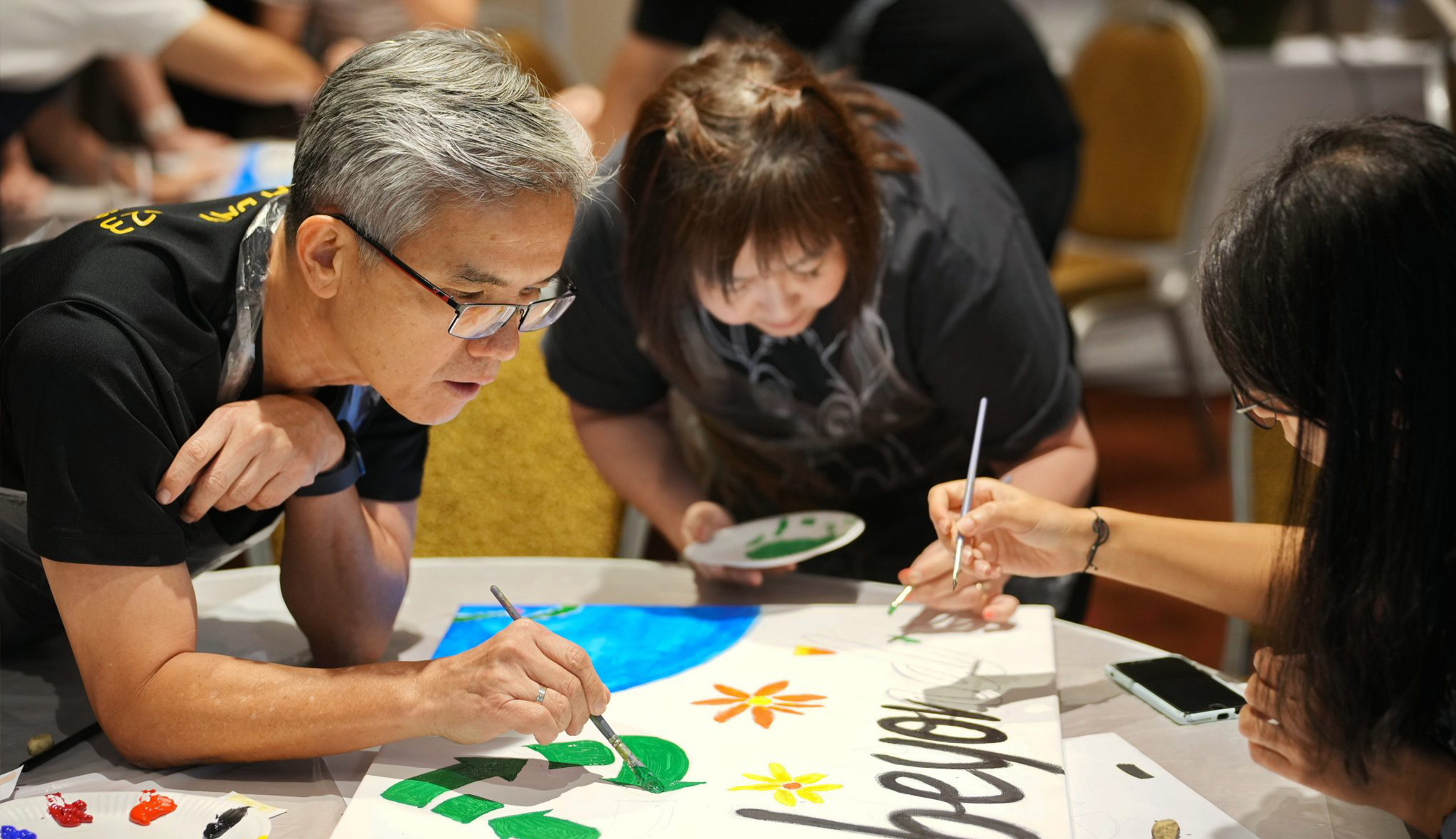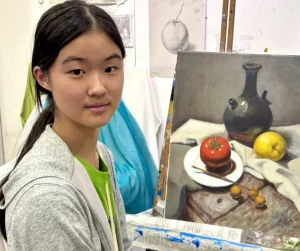Acrylic Painting on Canvas Team Bonding Art Jamming Singapore Visual Arts Centre

























With its principal subject being a scenic view, for example: forests, valleys, mountains, trees, and rivers, landscape art has evolved through movements and periods. Important elements in landscape art also include the sky and weather as they provide the artwork with its mood and even emotion.
From as early as 4th-century-CE, landscape artwork (known as shan shui hua) can already be found in the East. It has played and has also been a major part of Chinese art. Shan shui hua features natural scenarios such as mountains, rivers, and waterfalls. The composition of shan shui hua consists of vanishing points known as ‘san-e-ho’. The points are the high distance, the deep distance, and the level distance. The points emphasize the height, depth, and leveled broadness of the painting. Balance, linear perspective, and form are of utmost importance in shan shui hua.
In the West, landscape art first emerged in the 16th century, where artists finally began to view landscape as a subject of its own in contrary to early art which focused on spiritual or historical subjects. However, landscapes were still often incorporated as settings behind the artist main subjects. It was only until the 17th Century where exotic landscapes became popular, as many people are able to view and get an idea of sceneries that they have not got the chance to see before, and that landscape as a genre continued to develop.
There are 3 types of landscape art: Romantic landscape, Impressionist landscape, and Abstract landscape. For romantic landscape, artists paints and/or sketch an idealised depiction of the landscape. Romanticism celebrates the imagination and intuition of the artist. For impressionist landscape, artists focus on depicting the ‘truths’. The artist will faithfully reproduce what they saw, for example, if the color of the lake at that time appeared pink, the artist would paint it pink. For abstract landscape, artists emphasise the two-dimensionality of their surface (canvas) and use color as a mode of expression rather than as a tool to capture atmospheric effects and the elements of nature. Instead of a precise depiction of the subject, the artist aims to convey the form, colors, effects, and the ‘sense’ of the subject.
A common practice of landscape artists is en plain air where artists sketch and/or complete their artwork outdoors. This practice allows artists to challenge themselves and master the techniques of light through the establishment of highlights and shadows in an ever-changing environment. This is because they will encounter various light sources such as direct sunlight, overcast sky, and candlelight. Each light has their own distinctive qualities where artists have to understand so as to paint their landscape convincingly.

The Starry Night (1889), by Vincent van Gogh. The Water Lily Pond (1990), by Claude Monet
Landscape art was also a genre that Vincent van Gogh has dabbled in throughout his prolific career. Rather than depicting the natural setting of the landscape, like most mid-nineteen century painters, to van Gogh landscape art is a celebration of nature and those that live within it to van Gogh. He made use of his signature exaggerated and expressive brushstrokes to reflect his inner thoughts and reveal his impression of the subject that he paints. In ’Starry Night’, van Gogh made use of contoured forms as a mean of expression and to convey the emotions that he felt inside.
Claude Monet, a founder of French Impressionist painting, was also known for his landscape artwork. He had a great interest in painting in the open air where he could capture the fleeting qualities of nature and was also interested in capturing natural light. He was a master in the use of color and explored the possibilities of a decorative paint surface of harmonies and contrasts of color. In ‘Waterlilies in the Pond’. Monet expresses his emotions towards the subject and depicts his observation with the orchestration of color, tone, and texture of the painting. A technique that he had used is taches, where he used short rapid brushstrokes and touches or dabs of pure paint, to create the water’s flower-laden surface. This technique provided texture to his painting to make it seem more dimensional.
At Visual Arts Centre, our art courses adopt an academy approach to art teaching and learning. Be it drawing and sketching or oil painting, after you have built your foundations, you are able to challenge yourself with landscape artworks. Landscape artwork teaches you the importance of space and depth in a composition and the concepts of foreground, middle ground, and background. In our drawing and sketching class, you will be provided with landscape images where you will learn to discover the form’s basic masses and shapes, explore shading to capture the illusion of natural light, and learn the concept of space in landscape art.
On our oil painting session, you will explore color theory, learn brushwork and techniques to capture the illusion of natural light, and increases your knowledge on visual arts concepts such as space, foreground, middle ground, and background. In our watercolor painting and acrylic painting class, composing landscape art challenges and improves your foundational techniques on brushwork, use of color, tone, and highlight which you have learned when composing still life art.
Here are some examples of still life artwork done by the students of VAC:

Explore landscape painting and sketching with us! Check out our art courses here.
Click and get to our WhatsApp
Embark on a captivating journey into the vibrant world of digital art! Our Foundation in Digital Art workshop invites budding creatives aged nine and above to unleash their imagination and hone their artistic skills in a dynamic, supportive environment. From mastering basic digital tools to crafting mesmerizing digital masterpieces, children will explore a spectrum of techniques guided by seasoned mentors. Through hands-on activities and interactive sessions, participants will discover the endless possibilities of digital expression while fostering creativity and critical thinking. Join us for an exhilarating adventure where young artists transform ideas into stunning visual realities, igniting a passion for digital art
In the Batik Introduction Handkerchief Painting workshop, participants will learn the traditional art of batik, a wax-resist dyeing technique originating from Indonesia. The workshop begins with a brief history and overview of batik, highlighting its cultural significance and various techniques. Participants will then observe a demonstration of applying wax with tjanting tools and dyeing the fabric. Following the demonstration, each participant will design and create their own batik handkerchief, applying wax to create patterns and then dyeing their fabric. The workshop concludes with a group discussion, allowing participants to share their creations and reflect on their learning experience.